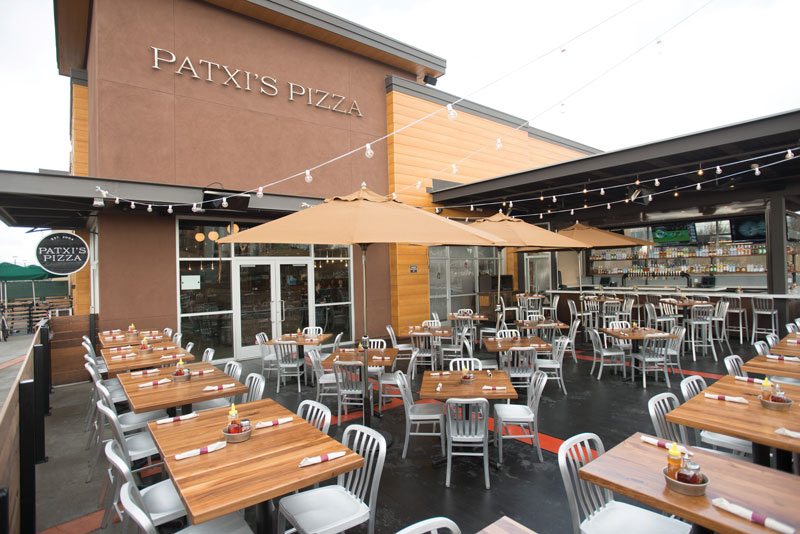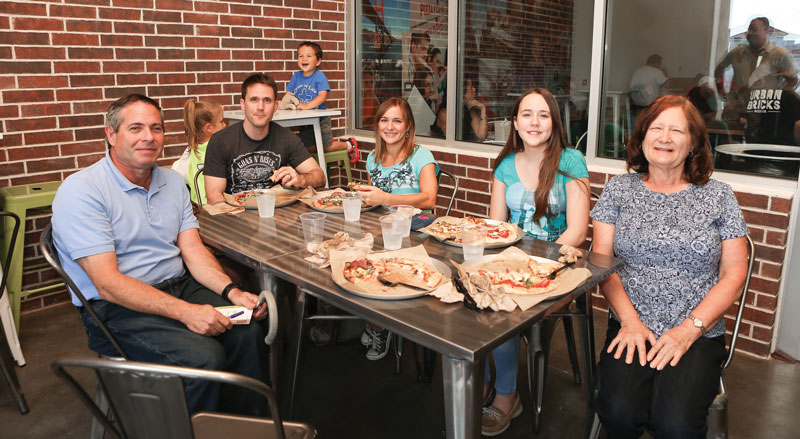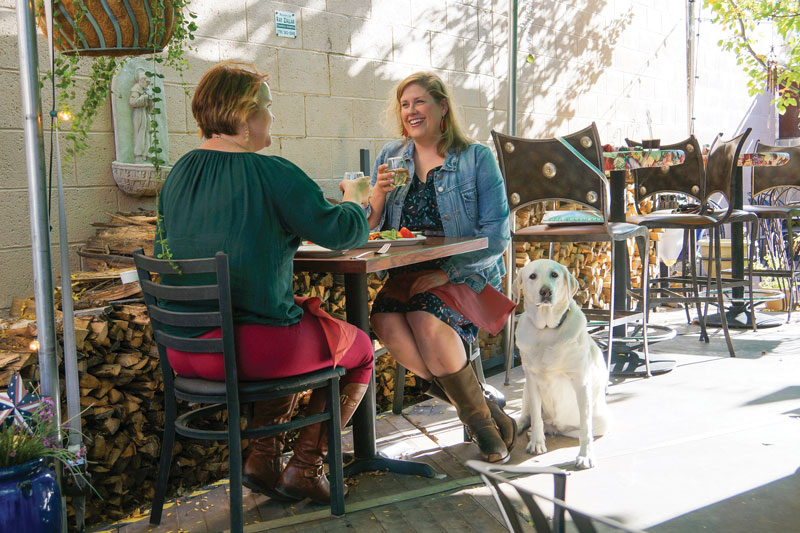As the springtime ushers in longer days and balmier nights, now’s the time to ask yourself if you can cash in on your outdoor space by adding patio dining. Customers are apt to flock to alfresco dining areas when the weather permits, which, depending on your location, could be seasonal or year-round. However, while outdoor dining can boost customer satisfaction, visibility, seating capacity and profits, it also offers unique challenges. Here, operators who have launched successful patios share their top tips for transforming the great outdoors into the perfect dining venue.
Breaking Out
Profit returns from patios can be (pun intended) sky-high: Restaurant and hospitality consulting group VSAG reported in 2013 that adding patio dining can achieve gross profits of up to 65%—all while adding little or no additional rent costs. “In most cases, you don’t pay rent on patios, so that’s free space to add more seating—you’d be crazy to not take advantage of that, since more seating usually means more sales,” says Bill Freeman, chief executive officer of Patxi’s Pizza, based in Sausalito, California. “For temperate climates, great outdoor seating is practically a requirement; in our Denver-area restaurants, there will be a waiting list for outdoor seats when the weather gets nice.”
Dave Brackett, proprietor of Pizzeria Rustica in Colorado Springs, Colorado, similarly found that, with a climate boasting 330 days of sunshine, a patio ramps up sales seven months of the year; he opens the area from April to October. And with only 42 chairs inside his restaurant, his alleyway patio seats 60, more than doubling capacity. “We pay a couple of bucks per square foot for the patio, as opposed to $50 for indoors,” he says. “The patio generates a good portion of our business, since we’re located in a tourist area—about 50% of business four months out of the year.”
 |
|
An outdoor dining space, such as the one at Patxi’s Pizza in Sausalito, California, can generate gross profits of up to 65% with little or no additional rent expenses, according to restaurant consulting group VSAG. Photo courtesy Paxti's. |
Outdoor dining offers multiple benefits for Topp’d in Kansas City, Kansas, even though owner Chad Talbott originally doubted the option. The patio’s fence and umbrellas helped increase visibility, drawing attention to the business, which otherwise can be easy to miss on a busy street. “We realized that the extra seating could be a huge draw during the summer months, and we knew it was right for us when we saw our lunches really bump up in sales,” Talbott explains. “We have a large working population nearby, with a hospital across the street, and it gave our customers one more reason to get outside their work environment. I think that’s the main effect of the patio seating for us: truly adding to the customer’s experience, not simply gaining a few seats.”
Indeed, just as important as increased sales, outdoor dining adds the intangible benefit of improving customer satisfaction. “Being based in Texas, we’re used to beautiful, sunny days, when our customers enjoy time outside, making an outdoor patio a necessity,” says Sammy Aldeeb, owner and franchisor for Urban Bricks Pizza in San Antonio, Texas. “When building out the look and feel, it was imperative that this would be a restaurant people visit not only for the food, but for the experience.”
Urban Bricks takes full advantage of its outdoor spaces for both dining and special events, hosting live music on the first and third Thursdays of the month and holding dog-friendly events, such as Dogs Night Out and Yappy Hours, where the pizzeria partners with local nonprofits for pet adoptions and hosts fundraisers for nearby businesses and communities. Pet owners and their pooches also flock to Pizzeria Rustica’s patio, a pet-friendly haven where the doggies are just as well taken care of as their owners; servers even provide water dishes and treats (dubbed “puppy antipasto”) for their four-legged patrons.
Spacing Out
Creating a welcoming patio is a must to maximize your space, but costs can quickly accumulate. Talbott minimized expenses by asking his landlord to assist with any changes that improved the property—including permanent outdoor trash receptacles and a fence around the area for seating. Meanwhile, other purchases were designed to improve the outdoor experience, such as decorative corded light strands and umbrellas. “Umbrellas and outdoor lights were a great investment; they provide a nice ambience for the space and make it much more visible from the road,” he notes. “Nothing says ‘Eat here!’ like bright red umbrellas and tables outdoors.”
Adding climate control measures—such as umbrellas, fans and heating lamps—also allow your patio to be used during sun-laden days and cooler nights alike. “At our flagship store, the outdoor patio space is covered by a roof, and at our second location we have two outdoor seating areas, one covered by the roof and the other (separate from the restaurant) with umbrellas,” Aldeeb says. “In our opinion, a roof or awning is the best option.” Urban Bricks also installed an oversize fan to offer relief in hot Texas summers, as well as built-in gas heaters to warm up the area on cooler fall or winter evenings. Decor was kept relatively simple, with only a couple of TVs and brushed-chrome tables and chairs.
Brackett kept costs in check by purchasing inexpensive black metal patio furniture from area suppliers. “It’s reasonably comfortable—we have pillows available on request—and very durable—we’re going on nine years with our original furniture. It’s easy to move around and easy to touch up paint, which we do each year,” he explains. He also places a 20’-by-20’ tent in the middle of the patio, supplemented with large umbrellas from his beverage distributors. Pizzeria Rustica also regulates temperatures with seven patio heaters, including one with a flame for ambience. A large fountain, dozens of potted and hanging plants (including an herb garden that staff members pick from for cooking), and the wood for its wood-fired oven are on prominent display to add to the patio’s charm.
Talbott also purchased furniture from a retail store and obtained umbrellas online. “The purchases we made definitely had to be carefully considered,” he says. “Umbrellas that don’t have a UV-resistant coating will end up being replaced after just one season, and cheap furniture will fade or blow over easily. Overall, I think a patio is a great investment for an operator; it can get pricey, but there are ways to bring the costs down if you’re willing to do your research.”
 |
|
In addition to outdoor dining, Urban Bricks, located in sunny San Antonio, uses its patio space to host live music twice a month and dog-friendly events that promote pet adoption and benefit local shelters. Photo by Urban Bricks. |
Stepping Out
In addition to decor needs, patios require extra manpower to ensure proper staffing and flow. “Once you have your location and have found good seating solutions and made sure you’re compliant with any applicable zoning or alcohol laws, the next challenge is staffing: Is there a good flow for servers to get in and out? Do you have enough staff?” Freeman notes. “Service is key. You want to make sure your guests sitting outside are as well taken care of as your indoor guests, so you need to have enough staff that are well-trained to check on outside tables.”
Pizzeria Rustica dedicates two to three servers and a hostess for the outdoor area, while an outdoor bussing station allows for seamless cleanup. “We didn’t want staff taking dirty dishes in the same door customers are exiting to sit outside,” Brackett explains. “We also have a space for water and tea, plus a beer cooler, which limits running back and forth. All we bring from inside is the food.”
Urban Bricks doesn’t have a full-service waitstaff, so the main priority is making sure its cleaning crew is attentive to the outdoor area. Topp’d also ensures that staff attends to the patio, especially during busy periods to increase turnover. “Sales can increase only to a certain point based on capacity, which is especially true in a fast-casual setting during lunch,” Talbott notes. “It depends on your available seating whether people will stay when you’re slammed. We never had a lot of tables to begin with, due to our small square footage, but the patio was a nice add-on that helped boost our lunch business.”

Patios may pose security challenges, too. Brackett had to enclose the area with a fence so people wouldn’t “wander in” from the street or leave the premises with alcohol. “We need to lock up the beer cooler and furniture to prevent theft, since we don’t have the space to take it inside,” Brackett says. “And we installed proper lighting and security cameras to monitor the area.”
Overall, patios may require extra staff and vigilance, but they can be a true boon for business. “If you have the space, it’s probably a good idea to add outdoor dining,” Freeman says. “When the weather is nice, outdoor seating is something many of your guests will be looking for; if you don’t have it, you will lose guests to your competitors.”















